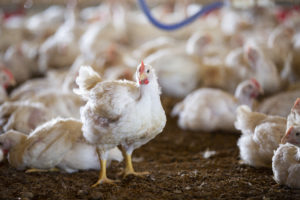Monitoring and Maintaining the Health of the Flock
Three times a day, farmers make the rounds to check on the health of the chickens. The temperature in the barn and all environmental factors are checked, and all 25,000 chickens in the barn are surveyed to make sure that they are all in good health and able to access food and water independently. Today, through improvements in nutrition, housing, breeding, veterinary care and bird health – chickens’ mortality rates have dropped by 71%, compared to previous years. That’s a number we’re proud of, but we also know there’s still work to do to continue improving how we care for our birds.
If a chicken is found to be ill, a flock will be treated – possibly including antibiotics – to bring it back to health. Chickens with an illness or ailment, like a broken leg, that cannot access feed or water on their own will be humanely euthanized by trained animal welfare representatives or farmers, to prevent suffering. This process is called culling and it involves cervical dislocation, a process in which a chicken’s neck is quickly and humanely broken. This method of euthanasia is approved by the American Veterinary Medical Association.
